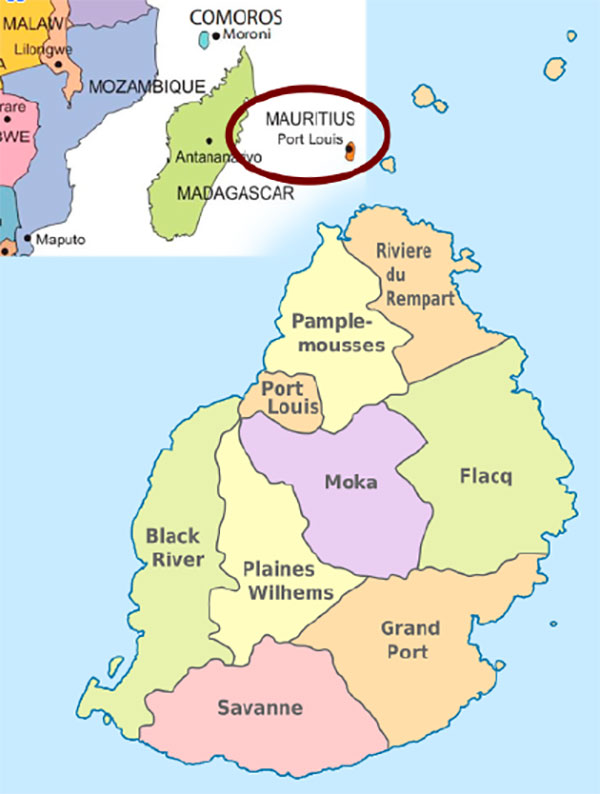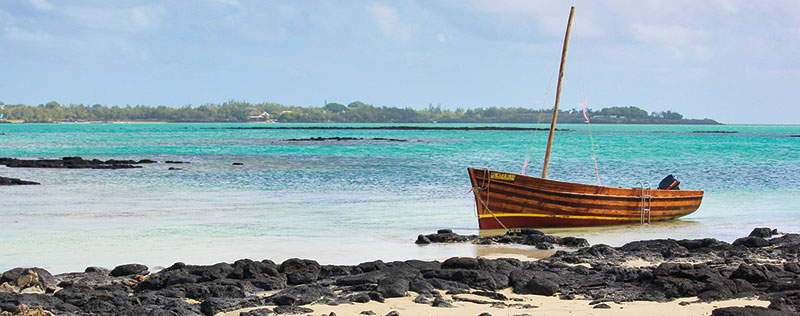
In our series, Island LIFE, Janet-Lynn Vorster, takes us 2,000 kilometres (1,243 mi) east of the South African coast to the tropical Indian Ocean island of Mauritius. In this post, she introduces us to life on the island and takes us around the Pamplemousses botanical gardens, the tea-route, and swimming with dolphins. In another post, read she tells us about some of the many shipwrecks scattered around the island. In a third and fourth post (COMING SOON), she will take us to all nine districts around Mauritius, its islets, markets, and also tell us about the interesting island of Rodriques.
Table of Contents
Welcome to the island of Mauritius
Think turquoise crystal sea, black volcanic rock, palm trees, sugar cane fields and craggy mountain peaks. Add waves crashing relentlessly against high cliffs, strong currents, lush green vegetation and waterfalls. Surround this with coral reefs and you know you are on the beautiful island of Mauritius, also known by its Mauritian Creole name, Île Maurice.
“Mauritius was made first and then heaven.”
– Mark Twain
Officially known as the Republic of Mauritius, named after Dutch Prince Maurice of Nassau, Mauritius is an African island located in the Indian Ocean about 2,300 kilometres (1,430 mi) off the southeast coast of Africa.
Mauritius includes many tiny islets scattered around the coast, as well as Rodrigues and the outer islands of Agaléga and St. Brandon. Mauritius and Rodrigues form part of the Mascarene Islands, along with nearby Réunion, a fellow member of the Indian Ocean Commission (IOC).

Photo: Janet-Lynn Vorster
The island of Mauritius consists of nine districts, one city, four towns and 134 villages. The capital, Port Louis, has around 140,600 inhabitants.
In this first part of a two-part feature on Mauritius, we focus on the climate, life in Mauritius, the botanical gardens, Mauritius Tea Route and the sugar industry, and we swim with the dolphins. We will add tips for travellers, a few interesting facts about Mauritius, and pique your curiosity a little on wreck diving. For those interested in mysteries related to lost continents, there is a section for you too.
In the next issue, we look at Mauritius by district, each with its main attractions and beaches. We visit the islets around Mauritius, give you some ideas on where to shop and which bazaars to visit. We wrap it up with useful information on how to negotiate with the local taxi drivers.
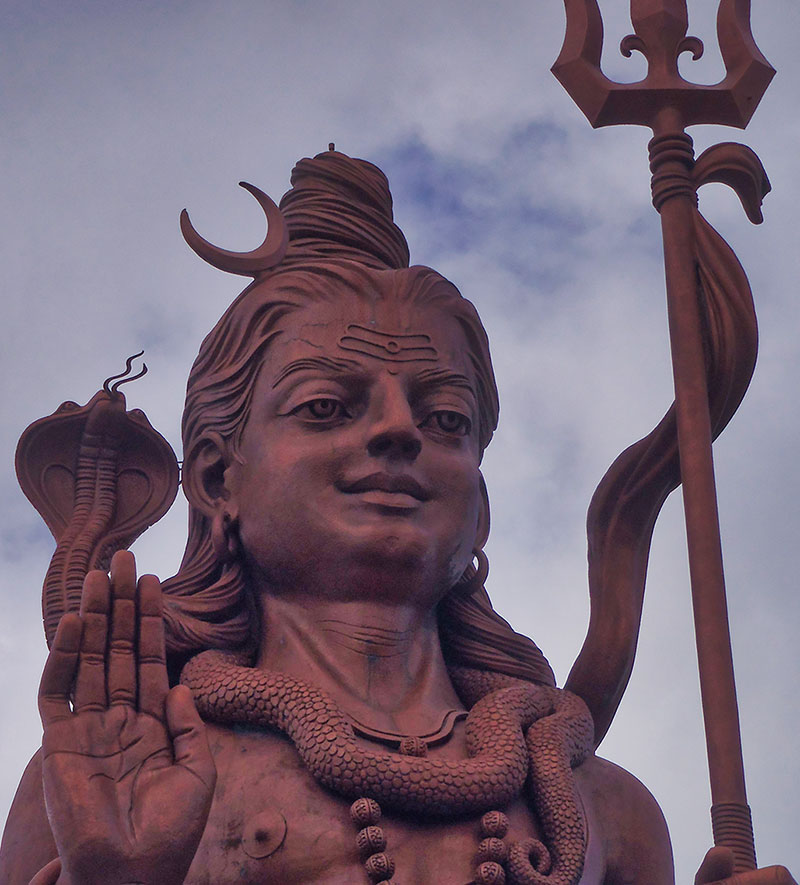
Photo: Janet-Lynn Vorster
Highlights of this beautiful island include idyllic beaches, snorkelling, diving, sea kayaking and boat trips to waterfalls, nearby islands or around the coast. Visit vibrant local markets and purchase speciality items like handcrafted wooden boats. Explore the Black River Gorges National Park, visit the caves and blowhole on the rugged southern coast and dare to try the longest zipline in the world. See waterfalls such as the jaw-dropping Chamarel falls. The Seven Coloured Earth sand dunes in Chamarel are an amazing natural phenomenon. Not to mention the temples, historical places, fishing, cuisine, rum and tea.

In short: Mauritius has something for everyone, young or old, adventurous or just curious to experience a little piece of paradise.
The Climate of Mauritius
There are only two seasons in Mauritius: summer and winter.
Summer, from November to April, has an average temperature of around 26°C. January and February are the hottest months with temperatures hovering around 28°C. Humidity is very high during summer, particularly in the coastal areas, and so it can become sweltering hot. High rainfall, tropical storms and occasional cyclones are pretty common during summer.
Winter is from May to October, when the average temperature is around 22°C. July is usually the coolest month of the year with an average temperature of 21°C. Generally, the cooler months are the best time to visit. I found September and October to be particularly lovely.
Life in Mauritius
The population density in Mauritius is one of the highest in the world, especially in Port Louis. Houses in Mauritius are not built for beauty, but to withstand the onslaught of cyclones. Cyclones have no respect for architectural design.
Houses are typically multi-storied structures, with many generations sharing a home. Each generation has their own level, and houses are often unfinished to avoid having to pay taxes.

Many houses are concrete structures with shutters which are bolted closed in extreme winds and cyclones. During summer, check ahead to make sure you have air conditioning. Mosquito nets are also very advisable.
Many houses have a predictable array of plants and trees in their gardens: a banana tree, coconut tree, papaya tree, mango- and/or lychee tree. Fruit trees are protected from bats that destroy the fruit virtually overnight. A curry tree which is annually cut down to knee height is a standard feature in many gardens too, and its fragrant leaves are added to many Creole and Indian dishes and have fabulous health benefits.
Mauritians have found innovative ways to use fruit before it ripens and is destroyed by bats and fruit flies. I loved the grated green mango salad with raw onions, salt, pepper and vinegar. Green banana curry is also a well-loved dish.
The locals eat plenty of fruit, vegetables, salad, beans and lentils. Meat dishes are generally chicken, lamb or fish. Cows are sacred in the Hindu religion and pork forbidden in many religions, so this is not cooked much. Duck is a favourite and I found pre-cooked duck in large tins – most delicious after being pan fried for a few minutes.
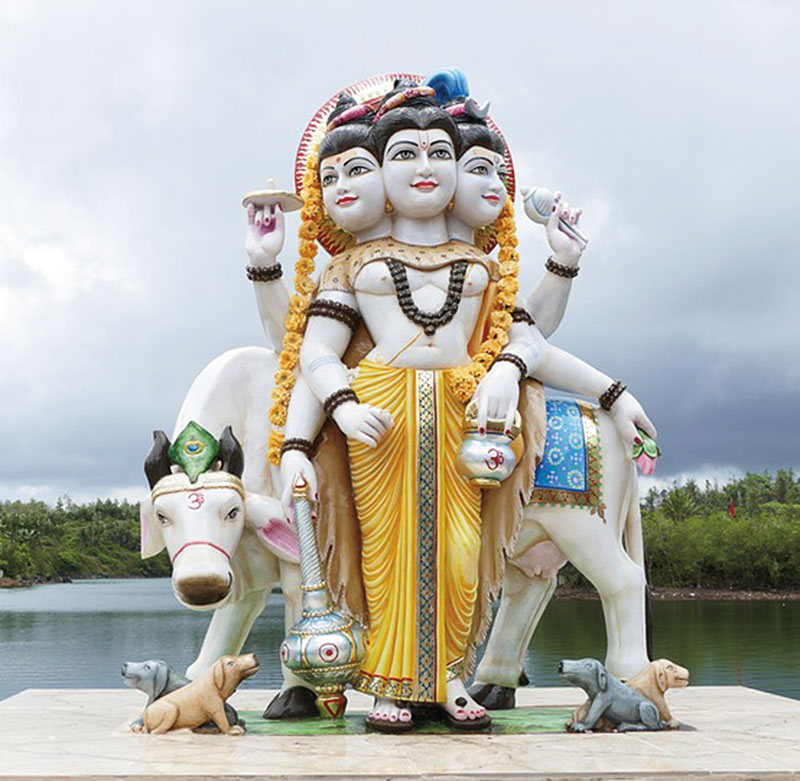
What I found fascinating in Mauritius when I first visited 20 years ago, was how people shared jobs. For two women, alternating and sharing a job meant sharing the responsibility of raising the children while each had time to cook and do household chores. I still marvel at this brilliant solution to joblessness, saving costs on daycare and ensuring that children are properly supervised and cared for.
This time when I was in Mauritius, it was noticeable how little poverty was visible. Questioning the locals uncovered the Mauritian strategy for the upliftment of their country which has the largest per capita earnings in Africa. Everyone here is educated. Schools are free and compulsory up to the age of 16. Schooling is either in French or English, and pupils learn the other as a second language, although English is the official language in Mauritius. The school system in Mauritius is heavily based on the British schooling system, and thus the standard of education is quite high and challenging.
Mauritius is a well-educated country and it shows.
Pamplemousses — Home of The Giants
A visit to Sir Seewoosagur Ramgoolam Botanical Garden, better known as the Pamplemousses Botanical Garden, northeast of Port Louis is non-negotiable. It is reputedly the oldest botanical garden in the Southern Hemisphere.
Here you will find the famous giant water lilies. When I was here in October 2018, the lilies were not at their prime. They were apparently decimated by apple snails, though the situation is being remedied and the lilies will soon regain their former splendour.
The garden is known by botanists worldwide for its enviable collection of indigenous and exotic plants including the numerous species of palm trees. Trees are well marked, and a stroll around the gardens is both educational and a delight for botanists and nature lovers alike.

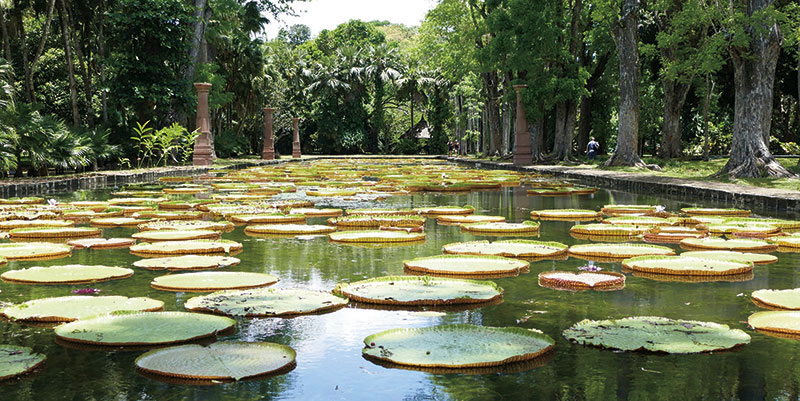
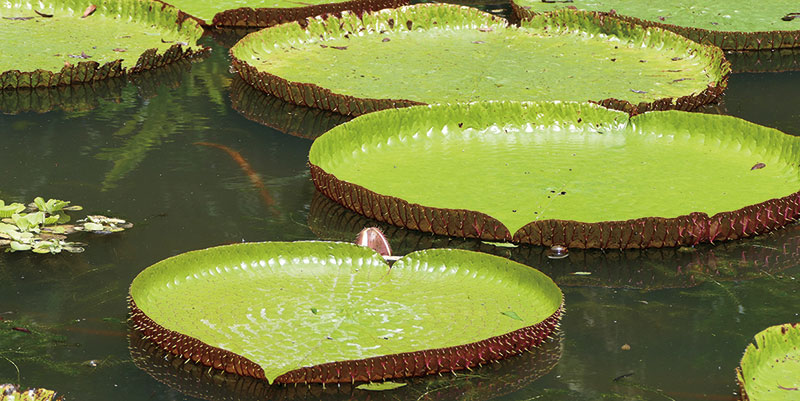
Historical Château de Mon Plaisir in the gardens is a fine example of a colonial mansion.
The second largest botanical garden in Mauritius is the Curepipe Botanical Gardens in Route des Jardins, Curepipe. This garden was created in 1870 for plants that thrive in cooler weather. The Pamplemousses Botanical Garden is far too hot for certain species.
Curepipe on the central plateau is the highest elevated town and therefore the coolest, while the northern part of the island is by far the hottest.
The Mauritius Tea Route
I love tea. I have found there is little that a hot bath and a good cuppa cannot fix. It is supportive and nurturing—a balm for the heart and soul.
Exploring the tea route of Mauritius is a delightful sensory experience. Discover the making of teas, rum, vanilla, and perfumes.
The tour starts in Curepipe at the stately Domaine des Aubineaux restaurant and museum. During the tour, you will also visit Bois Chéri, Domaine de Saint Aubin and Le Saint Aubin in the south.
“A spoonful of sugar helps the medicine go down.”
~ Julie Andrews, ‘Mary Poppins’ movie, 1964
Domaine des Aubineaux is a colonial house built in 1872 which has since been converted into a museum dedicated to the history of Mauritian tea. While here, visit La Maison des Essences, a range of perfumery for men and women, born from essences chosen with care by master perfumers. Enjoy buffet tea in their famous restaurant and tea room.
Bois Chéri is the first and biggest tea producer in Mauritius since 1892. Visit the plantations and factory and discover the history of tea while visiting the tea production museum. Of course, tea tasting is part of the experience.
Saint Aubin was built in 1819. It was home to managers of the sugar estate before being renovated in the ’90s. At Domaine de Saint Aubin, discover the fascinating transformation process of the vanilla orchid from flower to aromatic pod, visit the Anthurium greenhouses and the tropical- and spice gardens, and then taste and buy some rum.

Complete the tea route with a special, typical Mauritian lunch at Le Saint Aubin.
The island, with its characteristic sugar cane fields spread like a patchwork quilt on broad fertile plains, is home to several award-winning sugars. The fruition of a distinctive alchemy, they are sought after for high tea and fine dining worldwide. The island has a significant history linked to the sugar cane plantations. It is fascinating.
In 1863, there were 303 sugar refineries on the island, by 1993 there were only 42 left, and today only four remain. You can still see some old chimneys dotted around the countryside.
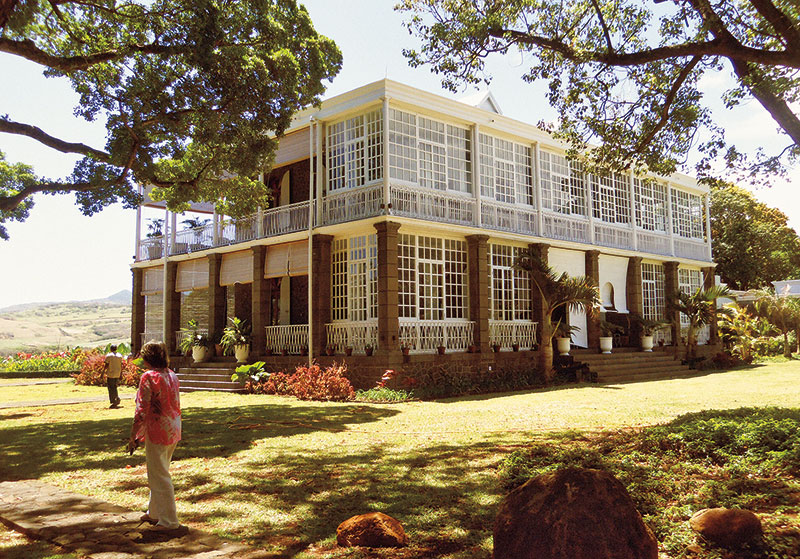
Photo: Janet-Lynn Vorster
Swimming with the Dolphins
I asked my friend Matthew Miles-Nell about his encounter with a pod of wild dolphins. This is his story:
“I have been extremely privileged to have had many magical experiences in my life, none of which compares to the experience of swimming with wild dolphins.
My husband and I, due to time constraints, were only able to have a “mini-moon” in Mauritius after our wedding in May, and I mentioned that I would really like to go swimming with dolphins. He was going to book online for Tamarin Bay, which is known for its exceptional dolphin sightings. Since our time was limited, we decided not to spend one of our precious days driving down the coast and back in the hope of finding a pod to swim with. We decided to rather enjoy the facilities of our beautiful Trou aux Biches Resort.
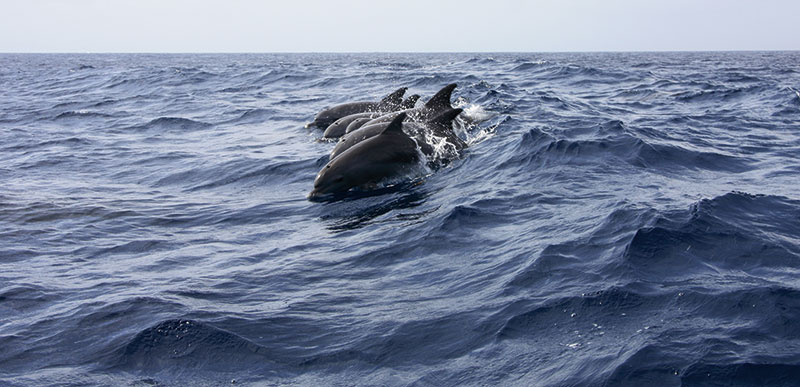
On our first morning, walking along the beach after breakfast, we were approached by Sanjay, a private boat operator. He mentioned that there were two large pods of dolphins swimming just on the other side of the reef, directly in front of our resort, and that this was a very rare occurrence. Sceptical at first, our busy minds turned to thoughts of divine intervention at play, and we decided to trust Sanjay.
At first, they swam deep, and due to poor visibility, this made it difficult to see them from the boat. On instruction from Sanjay we jumped into the water. Swimming in open water was exciting enough, let alone the thrill of encountering these majestic, sentient beings.
Hearing the dolphins communicating with one another reassured us they were still there. Initially, we struggled to see them clearly as they were diving to great depths, and we seemed to keep missing them every time they resurfaced to breathe.
At the last minute, just as I had lost all hope of viewing them in their glory, they changed direction heading straight for me. The speed and grace at which they swam were both beautiful and mesmerising. There were about 50 of them in the pod, including a very young calf swimming a mere three metres in front of me. I managed to keep up with them until my snorkel filled with water and I was forced to resurface.
To say the experience was breathtaking would be an understatement. Spending time with these gentle creatures was a uniquely magical and spiritual moment, and one I will cherish for the rest of my life.”
☛ Read more: Shipwrecks and wreck-diving off Mauritius island
☛ Read more: Mauritius island: Districts, beaches, islets, and shopping



Janet-Lynn is a numerologist by profession, and journalist, editor and photographer by hobby. She is the proud mother of three grown children and granny to three grandchildren.

